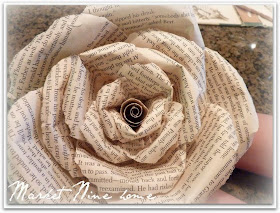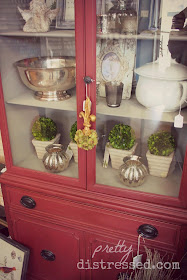I can speak to this issue about as well as anyone. My hubby is wonderful, but, for the most part, he was not interested AT ALL in helping with my booth. I was on my own when it came to buying and hauling for my booth. I don't blame him at all. He works very hard at his business. He has things to do around the house. Plus, his knees and elbows and shoulders "ain't what they used to be". In his spare time, he should be able to relax. His business slowed down for a few months and he was very helpful then - he even made a few fabulous tables. But when business picked back up, he once again couldn't / wouldn't / shouldn't...
I had a pity party for about two seconds and then began figuring out other ways to keep a booth going. I'm a fairly independent person anyway, so I like to figure out ways to do things without imposing on anyone else.
I have a Honda CRV. The back seats lay down. I can fit a standard sized chest of drawers in the back, but nothing bigger. I decided that I would buy what I could fit in my car and leave the bigger things for others.
Weight was another consideration. Hauling heavy furniture in and out of my house with no help was impossible. If I asked for help, I would get it, but I felt guilty for asking, even when he cheerfully helped. So.... I decided to only get heavier furniture if I could sell without a stop by my house. In other words, no heavy fixer-uppers.
Medium sized fixer uppers were my bread and butter! If I spotted a fixer upper I liked, I only bought it if I could lift it by myself and if it would fit in my car. Nothing too big OR too heavy.
Having mostly medium sized furniture might take a little more thought when creating an inviting booth. A booth looks best when it has at least a few large items. A booth that has all small or medium things can sometimes look rather unfinished and unimportant if it's not arranged creatively. Luckily, this is something that can be easily overcome. Just paying attention to how great booths are arranged can help you get better in your own booth.
OK. So the booth needs to have a couple of large things... even if you are only going to sell jewelry or other tiny things, you need something of substance to hold it all and make it look great.
If you're set on having an actual large piece for your booth, there are a number of ways to make that happen. You can work out an arrangement with another vendor. Vendors who have help often hauling don't have enough space in their booth to put all the things they buy. It's possible they may have a big hutch at home just waiting to bring in when something else sells. Or, the store owner may have a big piece you could use in your booth. Or you may work out a deal to split the cost (and profit) of a big piece with another vendor on a big item. They haul it in. You put it in your booth til it sells. Or, hire a college student to help you every now and then.
A different option (the one that will keep you independent) is to get the look of a big piece by combining two or three smaller items. You can get a look similar to the one below without a truck and without help. Find a small table with legs that come off. ( I don't think the legs on the table in this example come off, but you get the idea, right?) Many tables have screws for attaching the legs!!! Stack a shelf on top of the table. If you plan to paint them, coordinate the colors of both pieces as if they were a hutch. The color combination below is fabulous. White and wood. This arrangement has the presence of a hutch, yet one person can handle moving it.
 |
| Source I feel sure I've shown this photo before, but it's the perfect one for illustrating my point. |
Another way to fake a large piece is with a folding bakers rack. Those are fabulous to have as a backup for when a big piece sells and you need something fast to fill the spot. I think most vendors should have one of these.
 |
| Source |
You can totally skip large pieces if you are a bit creative. Take a look at the booth below. I saw it posted on Booth Crush (you are following that page, right?). I shared the photo on the VSO Facebook page, so you may have seen it already. It doesn't look like this person has any one large piece, but she has managed to stack things in such a way that you don't notice this right off the bat. I don't see anything in that booth that my CRV and I couldn't have handled.
 |
| Source Be sure to check out the source! There are some great booth pictures on her post! |
This next booth doesn't have anything too big or heavy. Nothing really large, but it's still nice.
 |
| I found this on Pinterest... but the source link was bad. :-( |
There's nothing too big or heavy in this one either! If those table legs unscrew, then it would be a cinch to move.
 |
| Source |
There are more good positives for focusing on medium sized pieces..
- If you ever decided to do an outdoor show, the setting up and tearing down would be so much easier on everyone.
- Hauling medium furniture is less likely to cause aches and pains. This is a BIG issue for people moving big things regularly.
- Your booth is easier to change around - it's more versatile. You can change how you have things paired up.
- Last but not least - medium sized furniture sells faster. Customers are more likely to make an impulse purchase for a small piece. They don't feel the need to measure and think it over. They don't feel like it's a purchase they'll have to live with for years if it doesn't work out. Also, most customers can take a medium sized item right home without having to call and ask for help from someone with a truck. They often have the same hauling issues you do! :-D
Final Note - This is a post I had on my to-do list, but something Brandi of Black Bear Prim wrote on her Facebook page recently inspired me to get the post out there. She was thinking about closing her booth. Her husband didn't want to deal with big pieces anymore. He's since changed his mind, but still, there may be times when big pieces aren't possible. I wanted to let Brandi know that if he can't help, she can still have a great booth. Where there's a will, there's a way!































.jpg)






